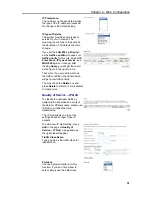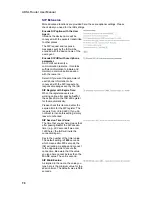
Chapter 4: Web Configuration
Virtual Server – Port Forwarding
The Router implements NAT to make your entire local network appear as a single
machine to the Internet. The typical situation is that you have local servers for
different services and you want to make them publicly accessible. With NAT applied,
it will translate the internal IP addresses of these servers to a single IP address that
is unique on the Internet. NAT function not only eliminates the need for multiple
public IP addresses but also provides a measure of security for your LAN.
When the router receives an incoming IP packet requesting for accessing your local
server, the router will recognize the service type according to the port number in this
packet (e.g., port 80 indicates HTTP service and port 21 indicates FTP service). By
specifying the port number, the router knows which service should be forwarded to
the local IP address that you specified.
After setting the virtual server, you should modify the filter rule about the port and
service information which you set on the virtual server. Because the firewall protects
the router by the filter rule, you should update the filter rule after you set up the
virtual server.
Virtual Server function allows you to make servers on your LAN accessible to
Internet users. Normally, Internet users would not be able to access a server on your
LAN because:
Your server does not have a valid external IP Address.
Attempts to connect to devices on your LAN are blocked by the firewall in this
device.
The Virtual Server feature solves these problems and allows Internet users to
connect to your servers, as illustrated below:
IP Address seen by Internet Users
Once configured, anyone on the Internet can connect to your Virtual Servers.
Please note that, in the above picture, both Internet users are connecting to the
same IP address, but using different protocols, such as
Http://203.70.212.52
and
Ftp://203.70.212.52
.
To Internet users, all virtual servers on your LAN have the same IP Address. This IP
Address is allocated by your ISP. This address should be static, rather than dynamic,
to make it easier for Internet users to connect to your Servers. However, you can
use Dynamic DNS feature to allow users to connect to your virtual servers by using
a URL, instead of an IP address.
83
















































